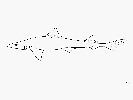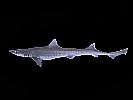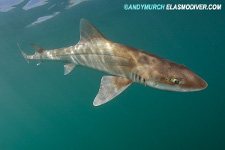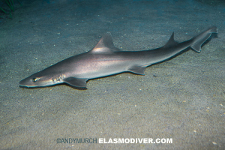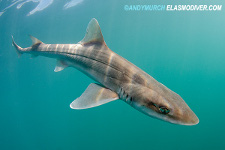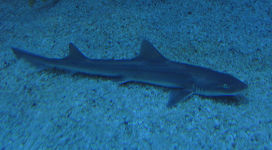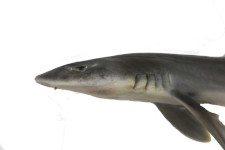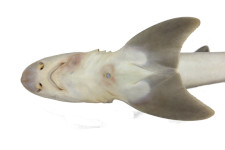Mustelus californicus
Gill, 1864
Grey smooth-hound
Classification: Elasmobranchii Carcharhiniformes Triakidae
Reference of the original description
Second contribution to the Selachology of California. Proceedings of the Academy of Natural Sciences of Philadelphia, 16, 147–151
Second contribution to the Selachology of California. Proceedings of the Academy of Natural Sciences of Philadelphia, 16, 147–151
Image of the original description
No image in first description.
No image in first description.
Synonyms / new combinations and misspellings
Galeorhinus californicus, Galeus californicus
Galeorhinus californicus, Galeus californicus
Description :
Citation: Mustelus californicus Gill, 1864: In: Database of modern sharks, rays and chimaeras, www.shark-references.com, World Wide Web electronic publication, Version 12/2025
Please send your images of "Mustelus californicus" to info@shark-references.com
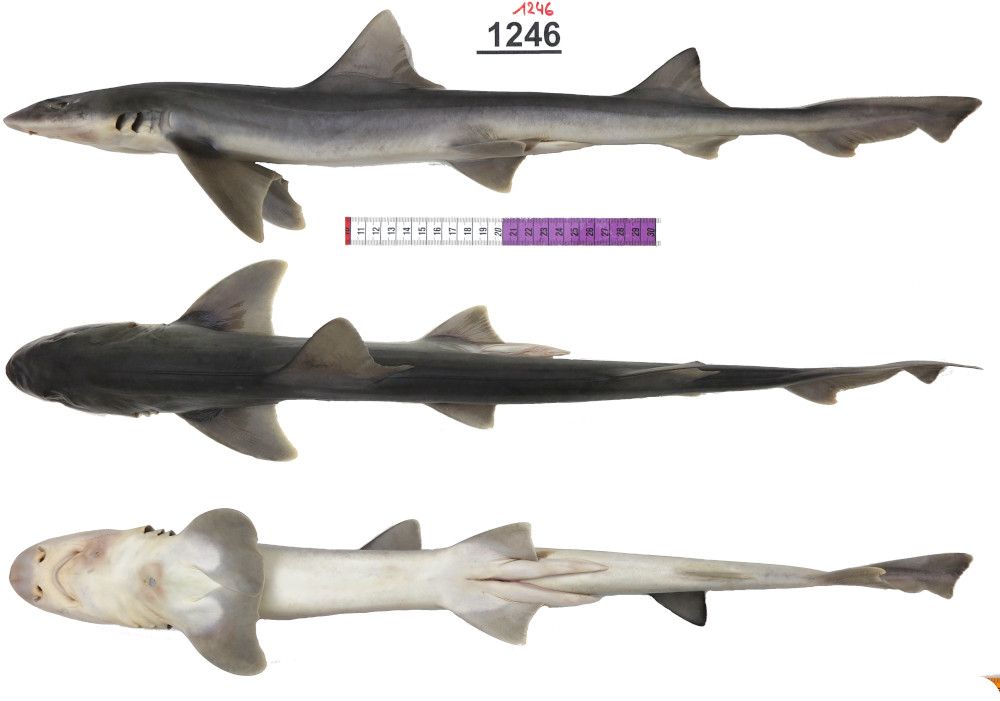
Mustelus californicus Gill, 1864, ERB 1246, male, 62, 4 TL, California, USA © Frederik Mollen, Elasmobranch Research, Belgium

Mustelus californicus Gill, 1864, ERB 1246, male, 62, 4 TL, California, USA © Frederik Mollen, Elasmobranch Research, Belgium
Common names
 Cazón gris,
Cazón gris,  Cazón mamón,
Cazón mamón,  Musola gris,
Musola gris,  Musola gris de California,
Musola gris de California,  Emissole grise,
Emissole grise,  Gray smooth hound,
Gray smooth hound,  Gray smoothhound,
Gray smoothhound,  Grey smooth-hound
Grey smooth-hound
 Cazón gris,
Cazón gris,  Cazón mamón,
Cazón mamón,  Musola gris,
Musola gris,  Musola gris de California,
Musola gris de California,  Emissole grise,
Emissole grise,  Gray smooth hound,
Gray smooth hound,  Gray smoothhound,
Gray smoothhound,  Grey smooth-hound
Grey smooth-hound
Short Description
Diagnosis after Compagno, 1984 [517]: Body fairly slender. Head short, prepectoral length 16 to 20% of total length; snout moderately long and bluntly angular in lateral view, preoral snout 5 to 7.2% of total length, preorbital snout 6.1 to 8% of total length; internarial space broad, 2.1 to 2.9% of total length; eyes fairly small, eye length 2.5 to 3.4 times in preorbital snout and 1.9 to 3.3% of total length; interorbital space narrow, 3.5 to 4.5% of total length; mouth short, subequal to eye length, its length 2.3 to 3.3% of total length; upper labial furrows usually equal to lowers, upper furrows 0.9 to 1.8% of total length; teeth molariform and asymmetric, with cusp reduced to a low point, cusplets absent; condition of buccopharyngeal denticles unknown. Interdorsal space 17 to 21% of total length; trailing edges of dorsal fins denticulate, without bare ceratotrichia; first dorsal broadly triangular to semifalcate with posteroventrally sloping or nearly vertical posterior margin, its midbase closer to pelvic bases than to pectorals; pectoral fins moderate-sized, length of their anterior margins 12 to 15% of total length, width of posterior margins 7.4 to 12% of total length; pelvic fins moderate-sized, length of anterior margins 7.1 to 9.2% of total length; anal height 2.3 to 3.7% of total length; anal-caudal space greater than second dorsal height, 5.9 to 8.6% of total length; ventral caudal lobe not falcate or somewhat falcate in adults. Crowns of lateral trunk denticles lanceolate, longitudinal ridges absent or extending about half of their entire length. Skeleton not hypercalcified in adults; palatine processes of palatoquadrates subdivided at symphysis, with a short separate medial segment on each side; monospondylous precaudal centra 32 to 40, diplospondylous precaudal centra 52 to 61, precaudal centra 89 to 98. Colour uniform grey above, light below, no white or dark spots or dark bars. Development viviparous. Size large, adults 57 to 124 cm.
Diagnosis after Compagno, 1984 [517]: Body fairly slender. Head short, prepectoral length 16 to 20% of total length; snout moderately long and bluntly angular in lateral view, preoral snout 5 to 7.2% of total length, preorbital snout 6.1 to 8% of total length; internarial space broad, 2.1 to 2.9% of total length; eyes fairly small, eye length 2.5 to 3.4 times in preorbital snout and 1.9 to 3.3% of total length; interorbital space narrow, 3.5 to 4.5% of total length; mouth short, subequal to eye length, its length 2.3 to 3.3% of total length; upper labial furrows usually equal to lowers, upper furrows 0.9 to 1.8% of total length; teeth molariform and asymmetric, with cusp reduced to a low point, cusplets absent; condition of buccopharyngeal denticles unknown. Interdorsal space 17 to 21% of total length; trailing edges of dorsal fins denticulate, without bare ceratotrichia; first dorsal broadly triangular to semifalcate with posteroventrally sloping or nearly vertical posterior margin, its midbase closer to pelvic bases than to pectorals; pectoral fins moderate-sized, length of their anterior margins 12 to 15% of total length, width of posterior margins 7.4 to 12% of total length; pelvic fins moderate-sized, length of anterior margins 7.1 to 9.2% of total length; anal height 2.3 to 3.7% of total length; anal-caudal space greater than second dorsal height, 5.9 to 8.6% of total length; ventral caudal lobe not falcate or somewhat falcate in adults. Crowns of lateral trunk denticles lanceolate, longitudinal ridges absent or extending about half of their entire length. Skeleton not hypercalcified in adults; palatine processes of palatoquadrates subdivided at symphysis, with a short separate medial segment on each side; monospondylous precaudal centra 32 to 40, diplospondylous precaudal centra 52 to 61, precaudal centra 89 to 98. Colour uniform grey above, light below, no white or dark spots or dark bars. Development viviparous. Size large, adults 57 to 124 cm.
Distribution
Eastern Pacific: northern California, USA to the Gulf of California. At the southern part of its range, this species is sympatric with Mustelus lunulatus, but the two are readily distinguishable. Source: www.gbif.org
Eastern Pacific: northern California, USA to the Gulf of California. At the southern part of its range, this species is sympatric with Mustelus lunulatus, but the two are readily distinguishable. Source: www.gbif.org
Human uses
fisheries: commercial; gamefish: yes
fisheries: commercial; gamefish: yes
Size / Weight / Age
116 cm TL (male/unsexed; [517]); 124 cm TL (female); max. reported age: 9 years (Ref. 6098)
116 cm TL (male/unsexed; [517]); 124 cm TL (female); max. reported age: 9 years (Ref. 6098)
Remarks
shark-references Species-ID=3783;
shark-references Species-ID=3783;
Parasites (arranged by Jürgen Pollerspöck)
Myxosporea
Monogenea
Cestoda
Trematoda
Myxosporea
- Chloromyxum ovatum Jameson, 1929 [23380]
Monogenea
Cestoda
- Dollfusiella litocephala (Heinz & Dailey, 1974) Beveridge, Neifar & Euzet, 2004 [16323]
- Dollfusiella litocephalus (Heinz & Dailey, 1974) Beveridge, Neifar & Euzet, 2004 [16112]
- Dollfusiella macrotrachela (Heinz & Dailey, 1974) Beveridge, Neifar & Euzet, 2004 [16323]
- Dollfusiella macrotrachelus (Heinz & Dailey, 1974) Beveridge, Neifar & Euzet, 2004 [16112]
- Lacistorhynchus dollfusi Beveridge & Sakanari, 1987 [16112]
- Symcallio pellucidum (Riser, 1955) [16383] [16201] [21796]
Trematoda
- Ptychogonimus megastomum (Rudolphi, 1819) [23771]








